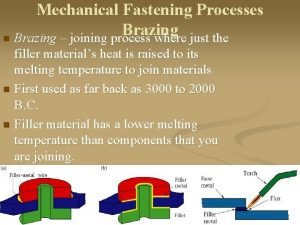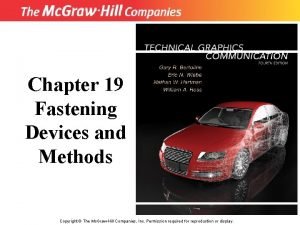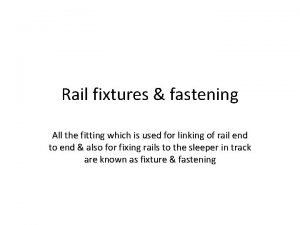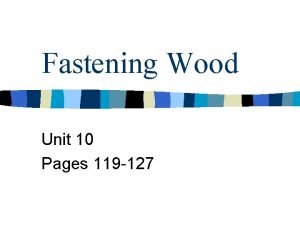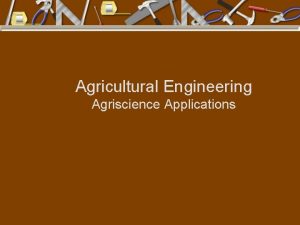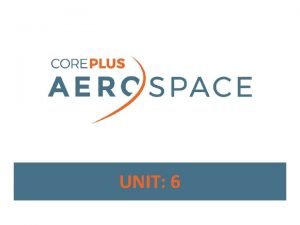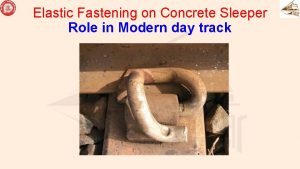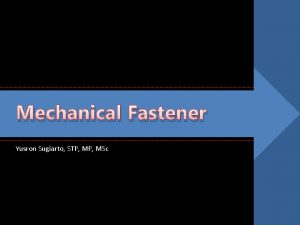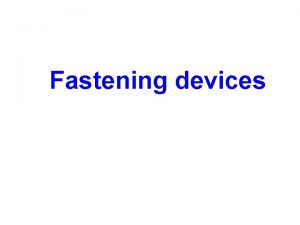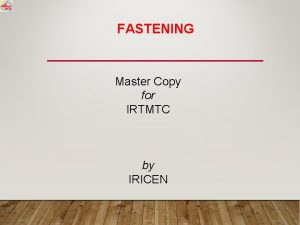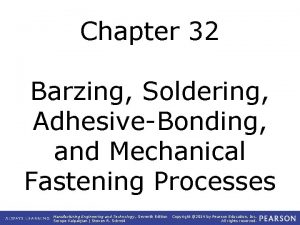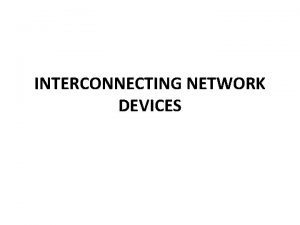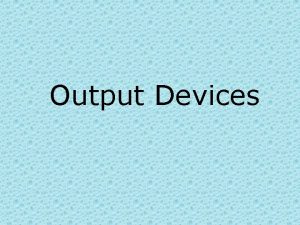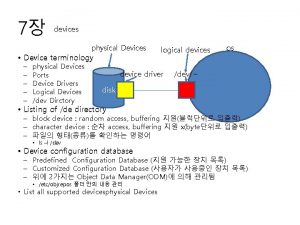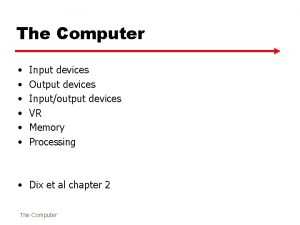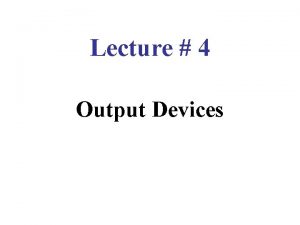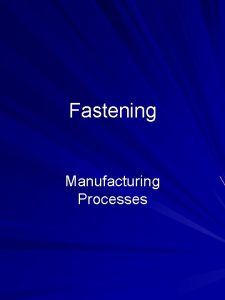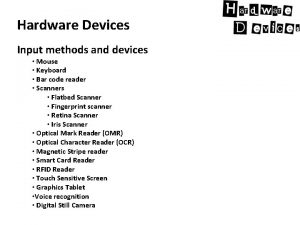Chapter 19 Fastening Devices and Methods Copyright The
























- Slides: 24

Chapter 19 Fastening Devices and Methods Copyright © The Mc. Graw-Hill Companies, Inc. Permission required for reproduction or display.

Fastening. Method of connecting or joining two or more parts together, using either devices or processes 3 Methods Mechanical- uses manufactured device to hold parts together Bonding- uses material to hold parts together (permanent) Forming- relies on shape of components to hold them together (least expensive, may be permanent) What are some Examples of Each?

Threaded Fasteners Formed w/ TAP for internal threads and DIE for external threads What are some Examples of threaded objects that are used for purposes other than fastening?

Helix Basic geometric form used for threaded fasteners (curve is formed by a point moving uniformly both an angular and a linear rate around a cylinder) Lead. Distance point moves parallel to axis in 1 revolution

3 Application of Threads Joining- connecting two or more parts temporarily or permanently Adjusting- Locating or modifying position of a part Power Transmission- transmit power force in one direction to another Examples of each? Bolts Wrench Ball Screw

Chamfer-the angular relief at the last thread; allows easier engagement with the mating part. Crest-the peak or top surface of a screw thread. Depth the distance between the crest and the root of a thread, measured normal to the axis. Root-the bottom of a screw thread cut into a cylinder. Lead-the distance a screw will travel when turned 360 degrees, or one revolution. Major diameter-the largest diameter of an internal or external thread. Minor diameter-the smallest diameter of an internal or external thread. Pitch-the distance between corresponding points on ad jacent thread forms. Thread Terminology

Thread Specifications Information Needed ¼ 20 UNC 2 A LH • Major Diameter • Threads per inch • Thread Form • Thread Series • Class of fit • Internal vs. External • If left hand noted

Thread Forms Unified Standard for fasteners Acme, Buttress, & Square transmit power Knuckle- Light bulbs, bottle caps, glass jars

Thread Series Standard # of threads per inch • (C) Course – quick assembly • (F) Fine- lots of force necessary • (EF) Extra Fine- Length of engagement is short

Appendix 17 Thread Series Standard # of threads per inch How many threads per inch can a ½” thread have in each of the series?

Class of Fit 1. Loose fit for quick assembly 2. General purpose 3. Close fit, for precision, high stress, and vibration Internal vs. External A=External B=Internal

Thread Notes English Units VS. Metric

Single and Multiple Threads Single- advances distance of one pitch for every 360 degree revolution (Pitch is equal to lead) Multiple- advances # of pitch faster with one revolution (used where quick assembly is required) Right and Left Hand Threads • Righty Tighty Rule • LH must be noted if left hand thread or counter clock wise tightening takes place

Tap Drill Notes Blind Hole without Bottom Tap

3 Method of Thread Drawings • Detailed • Schematic • Simplified

Pipe Threads Carry liquids and Gases 2 Types Taper and Straight

Design for Assembly (DFA) Design for Manufacturability (DFM) More than 50% of production time is spent in assembly or fastening Only 5% of cost is from fasteners Ways to Design Smarter: • Select standard fastener sizes • Select same size of fasteners as often as possible • Less tooling • Less Stations • Leave plenty of room for standard tooling (wrenches) • Use database of standard fasteners • Use Bolt Design Principles John Deere Example

Standard Bolt, Nuts, & Screws Main difference? Bolt- intended to be tightened/ loosened using a nut Screw- intended to be mated with an internal thread in a part Finished vs. Unfinished

Standard Nuts

Set Screws & other Threaded Fasteners

Shoulder Screws Hold machine parts together, have toleranced/ unthreaded shafts used as pivots and linkages Self tapping and wood screws

Locking Devices/ Retaining Rings Prevent threaded fasteners from coming loose Act as fastener due to profile 3 Series of washer N Narrow R Regular W Wide Used to improve assembly surface and increase the strength

Keys Used to attach two components such as a shaft and hub to transmit power to gears, pulleys and other devices Key sits in Keyseat 4 Major types of Keys

Rivets & Springs Attach parts permanently Expand or contract due to pressure or force
 Mechanical fastening
Mechanical fastening Permanent joining methods
Permanent joining methods Fastening devices
Fastening devices Fixtures in railway
Fixtures in railway Torsion snap joints
Torsion snap joints Vertical wall like structure enclosing a compartment
Vertical wall like structure enclosing a compartment Unit 10 fastening wood answers
Unit 10 fastening wood answers Which is best for fastening wood at high stress points?
Which is best for fastening wood at high stress points? Fastening
Fastening Track fittings and fastenings
Track fittings and fastenings Kekuatan baut fisher
Kekuatan baut fisher Fabrication of wax pattern
Fabrication of wax pattern Literary technique vs literary device
Literary technique vs literary device Input or output devices of computer
Input or output devices of computer Hình ảnh bộ gõ cơ thể búng tay
Hình ảnh bộ gõ cơ thể búng tay Slidetodoc
Slidetodoc Bổ thể
Bổ thể Tỉ lệ cơ thể trẻ em
Tỉ lệ cơ thể trẻ em Gấu đi như thế nào
Gấu đi như thế nào Tư thế worm breton là gì
Tư thế worm breton là gì Hát lên người ơi
Hát lên người ơi Các môn thể thao bắt đầu bằng tiếng bóng
Các môn thể thao bắt đầu bằng tiếng bóng Thế nào là hệ số cao nhất
Thế nào là hệ số cao nhất Các châu lục và đại dương trên thế giới
Các châu lục và đại dương trên thế giới Công thức tính thế năng
Công thức tính thế năng
